Ijraset Journal For Research in Applied Science and Engineering Technology
- Home / Ijraset
- On This Page
- Abstract
- Introduction
- Conclusion
- References
- Copyright
A Review on Crack Detection in Wind Turbine Blade
Authors: Pratham S. Madhav, Darshan D. Matavkar, Nikhil S. Mayekar, Mandar M. Parsekar
DOI Link: https://doi.org/10.22214/ijraset.2024.60680
Certificate: View Certificate
Abstract
It was observed that there is a need to reduce of maintenance and operational cost of Wind Energy conversion System. The most efficient way of reducing this cost would be to carry out Non-destructive techniques (NDT) and continuously monitor the condition of the system. This allows for early detection of the blade Cracking or damage, minimizing downtime, and maximizing productivity. The importance of condition monitoring and fault diagnosis in WECS (blades) and keeping in mind the need for future research, this paper is intended as a brief status describing different type of faults, methods of detection and future aspects.
Introduction
I. INTRODUCTION
Wind energy conversion is the fastest-growing source of new electric generation in the world and it is expected to remain so for some time. At the end of 2003 the installed wind capacity stood at over 40000 MW, having doubled since 1999, and it has exceeded 95000 MW by the end of 2008[1]. But the higher target is to achieve 12% of the world’s electricity from wind power. So, to achieve this target the number of wind turbine must be increased and the most important thing is to reduce the downtime of the existing wind turbine, and if we are able to achieve this target in future then we will be depending upon the renewable energy resource which is wind, then being depending upon the non-renewable energy resources such as thermal power plants[2]
Under normal working conditions, wind turbine blades suffer from the wind loads which drive the blades rotation and rotate the motor’s rotor to generate electricity and store it. After a prolonged period of time, turbine blades suffer from fatigue induced degradation due to cycling loads, and cracks will initiate in the materials of the blade. Under the right conditions, the cracks will develop rapidly and lead to the failure of a wind turbine blade, or even the collapse of the whole wind turbine. In general, strong winds, lightning, climatic changes, corrosion, scratches due to wearing out of the protective film, ice saturation or even collisions with birds flying around the turbine are responsible for the damage and cracking of wind turbine blades (CWIF 2012)[3].
Wind energy capacity was observed to increase exponentially which shows the reliance of countries as increased utilization of non-convectional energy sources.
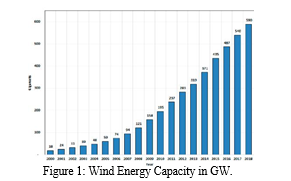
Autonomous online condition monitoring systems with integrated fault detection algorithms allow early warnings of mechanical and electrical faults to prevent major component failures. Side effects on other components can be reduced significantly. Many faults can be detected while the defective component is still operational.
Thus, necessary repair actions can be planned in time and need not to be taken immediately. By using the Non-destructive techniques such as the vibration analysis, ultrasonic testing, acoustic emission transducers and many more help in identifying the fault easily and carry out the remedial action in time.
II. FAULTS IN WIND TURBINE BLADES
As the number of wind turbine are increasing to increase the energy generation the faults occurring in the wind turbine are also increasing, which restrict the growth in energy generation and increases the downtime and maintenance cost. The most occurring damages in the wind turbine are in the mechanical and electrical components. The mechanical components include blades, hub, rotor, mechanical or pitch control system, hydraulic system, gearbox, air brakes, mechanical brakes and main shaft. The electrical components include generator, electrical controls, grid/ electrical system and wirings and control box[4].
The major faults occurring in the wind turbine blades are trailing edge cracking, lighting damage, pollution in the air, erosion due the daily working, contamination at leading edge, icing, delamination, longitudinal cracks, 45-degree cracks, edge wise cracks and surface stripping of edges etc.
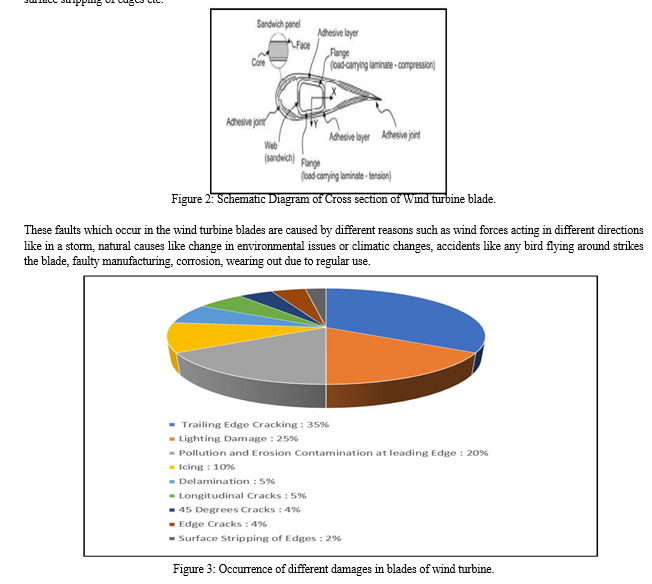



III. METHODS OF FAULT DETECTION
The most important part is which method you are going to use for the fault detection in the wind turbine blade. The selection of the methods for fault identification is a very difficult part and may vary as per every situation.
The selection criteria of the method of fault identification in the wind turbine depends upon the cost of the components used in the identification process, we have to take a deeper look into the advance technology if any available in the method such as online condition monitoring on the component, how efficient is the method and is the fault diagnosis possible, what is the deployment or the current status of the method, what type of the sensors are used to convert the mechanical stress which is generated in the wind turbine blade to the electrical energy which can be further decoded by the data acquisition system and on which component the method can be used.
Below Given are some condition monitoring techniques which are used in day-to-day life. There different properties are also given below on which we can classify then as per our needs[15][16][17][18].
A. Condition Monitoring Techniques
Condition monitoring (CM) is a maintenance technique that combines machine sensor data with software to predict machine health and safety. CM uses real-time data to measure vibration and other parameters. Vibration analysis a well-known predictive maintenance method that uses vibration sensors to measure vibration data from previous experiments. Vibration patterns can indicate equipment failure, and vibration monitors can identify defects months before problems become serious. Thermography non-contact technique that can be performed while equipment is running, reducing the need for predictive maintenance outages. Ultrasonics a common technique in mechanical applications that measures high-frequency signals to help companies understand how friction or other bearing defects can increase.

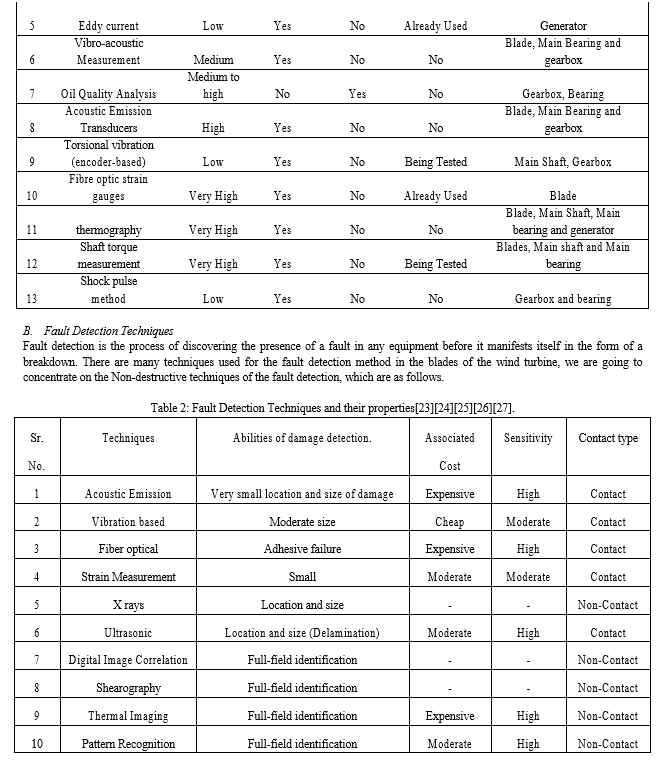

The above given techniques provide the information that which of the technique is most likely suitable for the particular defect. Each and every technique has its own ability and capacity of fault detection. Shearography, also known as speckle pattern shearing interferometry, is a non-destructive optical technique that uses laser speckle patterns to measure surface and subsurface damage in structures. It's similar to holographic interferometry and uses coherent light or coherent soundwaves to provide information about the quality of different materials. Digital Image Correlation (DIC) is a non-contact optical technique that measures strain and displacement. It is a 3D, full-field technique that tracks grey value patterns to measure deformation and strain on almost any material. Piezoelectric sensors are devices that convert physical parameters such as pressure, strain, or acceleration into electrical signals without the need for an external voltage or current source. The prefix piezo- means "press" or "squeeze" in Greek. The sensors are small and highly sensitive, making them well-suited to everyday objects. Thermal imaging is simply the process of converting infrared (IR) radiation (heat) into visible images that depict the spatial distribution of temperature difference in a scene viewed by a thermal camera.
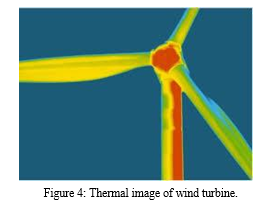
Acoustic emission (AE) is the phenomenon of radiation of acoustic (elastic) waves in solids that occurs when a material undergoes irreversible changes in its internal structure.
C. Ultrasonic
There are many methods used in the fault identification in the wind turbine blade which come under the category of Non-destructive Methods of identification, but the mostly used method which is having high efficiency is the Ultrasonic testing method.
High-speed Ultrasonic (UT) Systems enable a full volumetric examination of materials and are designed to detect surface, subsurface, internal and dimensional flaws.
This type of testing utilizes high-frequency sound waves that are transmitted throughout the material being tested in order to conduct a thorough inspection.
Ultrasonic inspection can be used to detect surface flaws, such as cracks, seams, and internal flaws such as voids or inclusions of foreign material. It’s also used to measure wall thickness in tubes and diameters of bars.
An ultrasonic wave is a mechanical vibration or pressure wave similar to audible sound, but with a much higher vibration frequency. For NDT purposes, the range is usually from 1MHz to 30MHz.
Depending on the test requirements, these waves can be highly directional and focused on a small spot or thin line, or limited to a very short duration.
Predictive maintenance vibration sensors are a proactive approach to maintenance that aims to predict when equipment failure might occur and to prevent it before it does. Ultrasonic sensors are a key tool in predictive maintenance, as they can be used to detect early-stage failures for example in slow rotating machinery which may not be easily detectable with vibration analysis alone[29].
The idea is that certain sound frequencies over the 20kHz range (over the human hearing limit) are produced when rotating machinery starts experiencing issues. These soundwaves called ultrasounds have short wavelengths and low energy, which does not allow them to travel long distances (materials attenuate them heavily). On the other hand, this short wavelength results in a high frequency (they are inversely proportional), which makes them very directional and it is easy to detect and filter them out from other acoustic signals, allowing them to pinpoint their source, thus the source of the machine fault.
There is no shortage of industrial applications where low RPM machinery requires maintenance. Vibration monitoring systems for Pumps, fans, entire HVAC systems, etc. have system components that rotate at low speeds. These are more difficult to monitor than ones that operate at higher speeds as several factors influence measurements in low frequencies:
Amplitudes (g levels) of vibrations for low RPS machines are very small, which makes them hard to detect unless a very sensitive accelerometer is utilized, however, these are expensive (500mV/g or better).
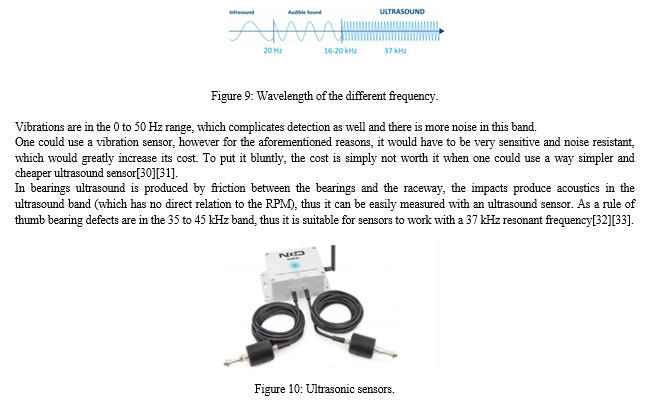
IV. SENSORS
Sensors are the most important thing or we can say the backbone of the non-destructive techniques used in the fault analysis of the wind turbine blades. There are different types of sensors and each and every sensor has its own advantages and limitations regarding its resolution and fault identification capacity. Below given sensors are mostly used in the fault identification methods, there advantages and limitations are also given which helps us to understand them perfectly[34][35][36].
Table 4: Types of sensors and their advantages and limitations
|
Sensor Type |
Advantages |
Limitations |
|
|
|
|
|
Strain Gauge |
Inexpensive |
Vulnerable to electrical disturbances |
|
|
|
|
|
|
Common, mature technology |
Prone to failures and noise |
|
|
|
|
|
|
|
Relatively low sensitivity |
|
|
|
|
|
Accelerometer |
Inexpensive |
Vulnerable to electrical disturbances |
|
|
|
|
|
|
Common, mature technology |
Usefulness focused mainly for modal |
|
|
|
analysis in vibration-based monitoring |
|
Acoustic |
High sensitivity to many different types of |
Must be near damage source for |
|
emission |
damage |
accurate measurement |
|
|
Helpful for vibration and wave |
Requires high sampling rate |
|
|
propagation-based methods |
|
|
|
Possible for use in damage visualization |
Influenced by material anisotropy |
|
|
and localization |
found in wind turbine blades |
|
PZT/MFC |
Active sensing possible |
Vulnerable to electrical disturbances |
|
|
|
|
|
|
Wide range of applications (i.e. |
Piezoceramics may be brittle |
|
|
impedance, wave propagation, vibration |
|
|
|
based) |
|
|
|
High sensitivity to structural changes |
Power amplification may be needed for |
|
|
|
active sensing applications |
|
|
Wide range of sensor geometries for |
|
|
|
different applications |
|
|
|
Inexpensive |
|
|
|
|
|
|
|
Potential for energy harvesting |
|
|
|
|
|
|
Optical fibre |
Immune to electromagnetic interference |
Fragile |
|
sensor |
|
|
|
|
Multiplexing possible (FBGs) |
May need temperature compensation |
|
|
|
due to cross sensitivities |
|
|
High precision |
Interrogator unit is expensive and bulky |
|
|
|
|
|
|
High sensitivity |
|
|
|
|
|
|
|
Individual sensor is inexpensive |
|
|
|
|
|
|
Scanning laser |
Noncontact sensing possible (nonintrusive) |
Requires pre-marking of the target |
|
doppler |
|
surface |
|
vibrometer |
|
|
|
|
High sensitivity |
Expensive |
|
|
|
|
|
|
More accurate than conventional sensors |
Precise setup required |
|
|
in obtaining deflection and mode shapes |
|
|
|
Does not affect structure due to lack of |
Surface optical properties affect |
|
|
mass load |
readings |
Conclusion
This paper provides an over view of the types of faults which can occur in the wind turbine blade, present fault identification techniques and also the condition monitoring techniques. Brief classification of the Non-destructive techniques are also given in this paper. The brief explain of the most used process which is Ultrasonic method is provided. The most important thing in the fault identification is the sensors, the various types of the sensors are provided with their advantage and limitation. In present study, almost all aspects of damage detection in wind turbine blade is presented up to date. This review will help the researchers to differentiate between various techniques involved in damage detection of wind turbine blade and selection of feasible approach on application to a structure more likely wind turbine blade.
References
[1] W. Yang, P. J. Tavner, C. J. Crabtree, Y. Feng, and Y. Qiu, “Wind turbine condition monitoring?: technical and commercial challenges,” no. August 2012, pp. 673–693, 2014, doi: 10.1002/we. [2] F. Art, “Wind Turbine Blades Manufacturing,” vol. 1, no. 19, 2011. [3] Y. Amirat et al., “Condition Monitoring and Fault Diagnosis in Wind Energy Conversion Systems?: A Review To cite this version?: Condition Monitoring and Fault Diagnosis in Wind Energy Conversion Systems?: A Review,” 2010. [4] A. Ghoshal, M. J. Sundaresan, M. J. Schulz, and P. F. Pai, “Structural health monitoring techniques for wind turbine blades,” vol. 85, pp. 309–324, 2000. [5] M. N. Scheu, L. Tremps, U. Smolka, A. Kolios, and F. Brennan, “A systematic Failure Mode Effects and Criticality Analysis for offshore wind turbine systems towards integrated condition based maintenance strategies,” Ocean Eng., vol. 176, no. January, pp. 118–133, 2019, doi: 10.1016/j.oceaneng.2019.02.048. [6] Z. Yang and Y. Chai, “A survey of fault diagnosis for onshore grid-connected converter in wind energy conversion systems,” Renew. Sustain. Energy Rev., vol. 66, pp. 345–359, 2016, doi: 10.1016/j.rser.2016.08.006. [7] G. Wu, C. Zhang, C. Cai, K. Yang, and K Shi, “Uncertainty prediction on the angle of attack of wind turbine blades based on the field measurements,” Energy, vol. 200, p. 117515, 2020, doi: 10.1016/j.energy.2020.117515. [8] Y. Du, S. Zhou, X. Jing, Y. Peng, H. Wu, and N. Kwok, “Damage detection techniques for wind turbine blades: A review,” Mech. Syst. Signal Process., vol. 141, no. xxxx, p. 106445, 2020, doi: 10.1016/j.ymssp.2019.106445. [9] J. F. Skov, M. D. Ulriksen, K. A. Dickow,P. H. Kirkegaard, and L. Damkilde, “On structural health monitoring of wind turbine blades,” Key Eng. Mater., vol. 569–570, pp. 628–635, 2013, doi: 10.4028/www.scientific.net/KEM.569-570.628. [10] J. C. Ã. Mar?, A. Barroso, F. Par?, and J. Can, “Study of damage and repair of blades of a 300 kW wind turbine,” vol. 33, pp. 1068–1083, 2008, doi: 10.1016/j.energy.2008.02.002. [11] S. Ataya and M. M. Z. Ahmed, “Forms of discontinuities in 100 KW and 300 KW Wind Turbine Blades,” Proc. 10th World Wind Energy Conf. Renew. Energy Exhib., vol. 0020, no. October 2016, pp. 2–7, 2011. [12] B. Yang and D. Sun, “Testing, inspecting and monitoring technologies for wind turbine blades: A survey,” Renew. Sustain. Energy Rev., vol. 22, pp. 515–526, 2013, doi: 10.1016/j.rser.2012.12.056. [13] I. Chopra and J. Dugundji, “Non-linear dynamic response of a wind turbine blade,” J. Sound Vib., vol. 63, no. 2, pp. 265–286, 1979, doi: 10.1016/0022-460X(79)90883-6. [14] M. M. Rezaei, M. Behzad, H. Moradi, and H. Haddadpour, “Modal-based damage identification for the nonlinear model of modern wind turbine blade,” Renew. Energy, vol. 94, pp. 391–409, 2016, doi: 10.1016/j.renene.2016.03.074. [15] H. J. Sutherland and W. Musial, “Application of nondestructive techniques to the testing of a wind turbine blade,” NDT E Int., vol. 27, no. 4, p. 209, 1994, doi: 10.1016/0963-8695(94)90446-4. [16] C. R. Farrar, S. W. Doebling, D. A. Nix, P. Trans, and R. S. Lond, “Vibration ? based structural damage identification Vibration-based structural damage identification,” pp. 131–149, 2001, doi: 10.1098/rsta.2000.0717. [17] W. T. Ndt, “WIND TURBINE NDT A review of NDT techniques for wind turbines,” vol. 49, no. 3, pp. 137–141, 2007. [18] A. María, P. Chac, F. Pedro, and M. García, “A review of non-destructive testing on wind turbines blades n,” vol. 161, pp. 998–1010, 2020, doi: 10.1016/j.renene.2020.07.145. [19] M. A. Rumsey et al., “Experimental results of structural health monitoring of wind turbine blades,” 46th AIAA Aerosp. Sci. Meet. Exhib., no. January, pp. 1–14, 2008, doi: 10.2514/6.2008-1348. [20] S. Kim et al., “Crack detection technique for operating wind turbine blades using Vibro-Acoustic Modulation,” Struct. Heal. Monit., vol. 13, no. 6, pp. 660–670, 2014, doi: 10.1177/1475921714553732. [21] L. Thomas and M. Ramachandra, “Advanced materials for wind turbine blade- A Review,” Mater. Today Proc., vol. 5, no. 1, pp. 2635–2640, 2018, doi: 10.1016/j.matpr.2018.01.043. [22] W. Hu, S. Thöns, R. G. Rohrmann, S. Said, and W. Rücker, “Vibration-based structural health monitoring of a wind turbine system . Part I?: Resonance phenomenon,” Eng. Struct., 2015, doi: 10.1016/j.engstruct.2014.12.034. [23] T. G. Carne and G. H. James, “The inception of OMA in the development of modal testing technology for wind turbines,” Mech. Syst. Signal Process., vol. 24, no. 5, pp. 1213–1226, 2010, doi: 10.1016/j.ymssp.2010.03.006. [24] W. Kim, J. H. Yi, J. T. Kim, and J. H. Park, “Vibration-based Structural Health Assessment of a Wind Turbine Tower Using a Wind Turbine Model,” in Procedia Engineering, 2017, pp. 333– 339. doi: 10.1016/j.proeng.2017.04.492. [25] C. C. Ciang, J. Lee, and H. Bang, “Structural health monitoring for a wind turbine system?: a review of damage detection methods,” 2008, doi: 10.1088/0957-0233/19/12/122001. [26] A. Saito, M. P. Castanier, C. Pierre, and O. Poudou, “Efficient nonlinear vibration analysis of the forced response of rotating cracked blades,” J. Comput. Nonlinear Dyn., vol. 4, no. 1, pp. 1–10, 2009, doi: 10.1115/1.3007908. [27] K. Sourabh and P. Suresh, “A Review on Experimental Methods in Health Monitoring Techniques for Wind Turbine Blade,” Int. J. Surf. Eng. Mater. Technol., vol. 11, no. 2, pp. 1–10, 2021. [28] W. Weijtjens, T. Verbelen, E. Capello, and C. Devriendt, “ScienceDirect Vibration Vibration based based structural structural health health monitoring monitoring of of the the substructures substructures of of five five o o ff ff shore shore wind wind turbines turbines,” Procedia Eng., vol. 199, pp. 2294–2299, 2017, doi: 10.1016/j.proeng.2017.09.187. [29] O. M. Analysis, “Odal parameter estimation for operational wind turbines”. [30] E. Di Lorenzo, G. Petrone, S. Manzato, B. Peeters, W. Desmet, and F. Marulo, “Damage detection in wind turbine blades by using operational modal analysis,” Struct. Heal. Monit., vol. 15, no. 3, pp. 289–301, 2016, doi: 10.1177/1475921716642748. [31] L. Doli?ski and M. Krawczuk, “Damage detection in turbine wind blades by vibration based methods,” J. Phys. Conf. Ser., vol. 181, no. 1, 2009, doi: 10.1088/1742-6596/181/1/012086. [32] G. Song, H. Li, B. Gajic, W. Zhou, P. Chen, and H. Gu, “Wind turbine blade health monitoring with piezoceramic-based wireless sensor network,” Int. J. Smart Nano Mater., vol. 4, no. 3, pp.150–166, 2013, doi: 10.1080/19475411.2013.836577. [33] P. J. Schubel, R. J. Crossley, E. K. G. Boateng, and J. R. Hutchinson, “Review of structural health and cure monitoring techniques for large wind turbine blades,” Renew. Energy, vol. 51, pp. 113–123, 2013, doi: 10.1016/j.renene.2012.08.072. [34] D. Tcherniak, S. Chauhan, M. Rossetti, I. Font, J. Basurko, and O. Salgado, “Output-only modal analysis on operating wind turbines: Application to simulated data,” Eur. Wind Energy Conf. Exhib. 2010, EWEC 2010, vol. 5, no. April, pp. 3550–3560, 2010. [35] Ö. Özdemir and M. O. Kaya, “Flapwise bending vibration analysis of a rotating tapered cantilever Bernoulli-Euler beam by differential transform method,” J. Sound Vib., vol. 289, no. 1–2, pp. 413– 420, 2006, doi: 10.1016/j.jsv.2005.01.055. [36] Y. Wang, M. Liang, and J. Xiang, “Damage detection method for wind turbine blades based on dynamics analysis and mode shape difference curvature information,” Mech. Syst. Signal Process., vol. 48, no. 1–2, pp. 351–367, 2014, doi: 10.1016/j.ymssp.2014.03.006.
Copyright
Copyright © 2024 Pratham S. Madhav, Darshan D. Matavkar, Nikhil S. Mayekar, Mandar M. Parsekar. This is an open access article distributed under the Creative Commons Attribution License, which permits unrestricted use, distribution, and reproduction in any medium, provided the original work is properly cited.

Download Paper
Paper Id : IJRASET60680
Publish Date : 2024-04-20
ISSN : 2321-9653
Publisher Name : IJRASET
DOI Link : Click Here
 Submit Paper Online
Submit Paper Online

